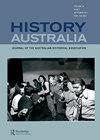Isobelle Barrett Meyering highlights the importance of children’s liberation in the first decade of the Women’s Liberation Movement in Australia
IF 0.4
Q3 Arts and Humanities
引用次数: 0
Abstract
In a context where cultural anxieties about children and young people regularly make headlines, Isobelle Barrett Meyering’s history of the ideas and practices of the children’s liberation movement in Australia in the 1970s is timely. She brings children’s liberation to our attention specifically through its presence in the Women’s Liberation Movement. Traces of the ideas of 1970s children’s liberation survive in the twenty-first century, in inspiring instances of political activism by children and young people. However, the formulation of notions of children’s rights through the radical ideas of Women’s Liberation has not been systematically recorded or remembered. The mutually constituting relationship between the two bodies of radical thought has been overlooked. Pronouncements like ‘Childhood is hell’ (1), made in 1971 by the influential US feminist writer Shulamith Firestone, and the slogan ‘Free Mum, Free Dad, Free Me, Free Child Care’, written on a banner held by children in the 1975 Sydney International Women’s Day rally, are exciting gems to retrieve from this period (57). The book draws from an archive of conference papers, feminist journals and books, government policy documents, children’s story books, personal papers and a handful of oral history interviews with key Women’s Liberationists who were motivated by the ideas of children’s liberation. After introducing key tenets of children’s liberation – which involves challenging hierarchical power relations between adults and children – the book is structured thematically. Chapter Two returns radical feminist thinking about the oppressive nature of the nuclear family to the history of childcare in the 1970s. Women’s Liberation contributed a unique perspective, one worth recalling as improving childcare these days is often justified only in terms of allowing women to participate in the workforce. Women’s Liberation mothers sought new modes of childcare at home as they monitored practices in existing childcare centres and established their own. Chapter Three discusses the multiple efforts made by feminists in response to the question ‘Are our schools sexist?’ (73). Feminists conducted research into educational practices, scrutinised children’s books and toys, wrote and published their own books, worked in unions and government, and were part of the伊索贝尔·巴雷特·迈耶林强调了儿童解放在澳大利亚妇女解放运动的第一个十年中的重要性
在对儿童和年轻人的文化焦虑经常成为头条新闻的背景下,伊索贝尔·巴雷特·迈耶林(Isobelle Barrett Meyering)对20世纪70年代澳大利亚儿童解放运动的思想和实践的历史研究是及时的。她让我们注意到儿童解放,特别是通过妇女解放运动。20世纪70年代儿童解放思想的痕迹在21世纪仍然存在,成为儿童和年轻人政治活动的鼓舞人心的例子。然而,通过妇女解放的激进思想来形成儿童权利观念的过程并没有被系统地记录或记住。两种激进思想之间相互构成的关系被忽视了。1971年,有影响力的美国女权主义作家舒拉米斯·费尔斯通(Shulamith Firestone)发表了“童年是地狱”的宣言,1975年悉尼国际妇女节集会上,孩子们举着的横幅上写着“免费妈妈、免费爸爸、免费我、免费儿童保育”的口号,这些都是这一时期令人兴奋的珍宝。这本书的材料包括会议论文、女权主义期刊和书籍、政府政策文件、儿童故事书、个人文件,以及对受儿童解放思想激励的重要妇女解放主义者的口述历史采访。在介绍了儿童解放的主要原则——包括挑战成人和儿童之间的等级权力关系——之后,这本书的结构是有主题的。第二章将激进女权主义者对核心家庭压迫本质的思考回归到20世纪70年代儿童保育的历史。妇女解放运动提供了一个独特的视角,值得回顾的是,如今改善儿童保育往往只有在允许女性参与劳动力方面才有道理。妇女解放运动的母亲们在监测现有托儿中心的做法并建立自己的托儿中心时,寻求新的在家托儿模式。第三章讨论了女权主义者在回答“我们的学校存在性别歧视吗?””(73)。女权主义者对教育实践进行研究,仔细检查儿童书籍和玩具,撰写并出版自己的书籍,在工会和政府工作,并参与了“女权运动”
本文章由计算机程序翻译,如有差异,请以英文原文为准。
求助全文
约1分钟内获得全文
求助全文
来源期刊

History Australia
Arts and Humanities-History
CiteScore
0.60
自引率
0.00%
发文量
103
期刊介绍:
History Australia is the official journal of the Australian Historical Association. It publishes high quality and innovative scholarship in any field of history. Its goal is to reflect the breadth and vibrancy of the historical community in Australia and further afield.
 求助内容:
求助内容: 应助结果提醒方式:
应助结果提醒方式:


